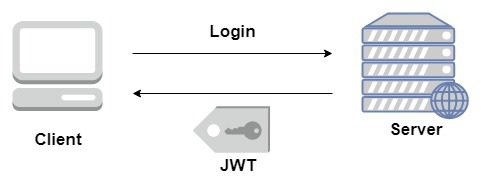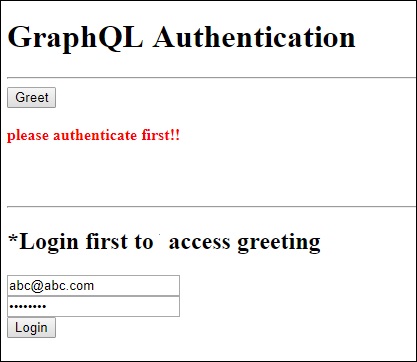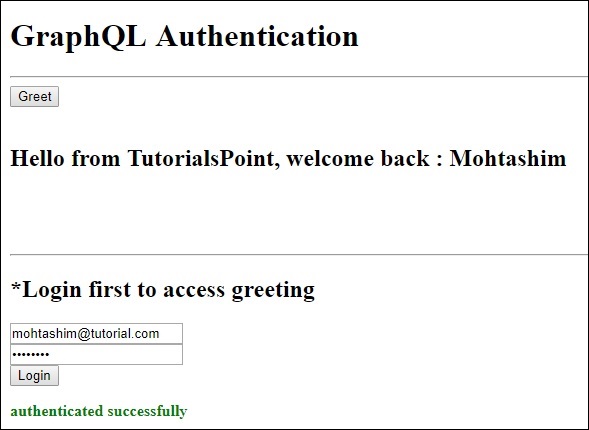GraphQL 验证客户端
身份验证是验证用户或进程身份的过程或操作。重要的是,应用程序对用户进行身份验证,以确保匿名用户无法使用该数据。在本节中,我们将学习如何验证GraphQL客户端。
1. JWT
在此示例中,我们将使用jQuery创建客户端应用程序。要验证请求,我们将在服务器端使用 express-jwt模块。
express-jwt模块是一个中间件,允许您使用JWT令牌验证HTTP请求。JSON Web Token(JWT)是一个标识登录用户的长字符串。
用户成功登录后,服务器将生成JWT令牌。此令牌清楚地标识日志。换句话说,令牌是用户身份的表示。因此,下次当客户端到达服务器时,它必须提供此令牌以获取所需的资源。客户端可以是移动应用程序或Web应用程序。

我们将按照逐步的步骤来理解这个例子。
2. 设置服务器
以下是设置服务器的步骤:
步骤1 - 下载并安装项目所需的依赖项
创建文件夹 auth-server-app。将目录 从终端更改为 auth-server-app。按照环境设置章节中说明的步骤3到5进行操作。
第2步 - 创建架构
在项目文件夹auth-server-app中 添加schema.graphql文件 并添加以下代码:
type Query
{
greetingWithAuth:String
}第3步 - 添加解析器
在项目文件夹中创建文件resolvers.js并添加以下代码 -
解析器将验证GraphQL的上下文对象中是否有经过身份验证的用户对象。如果经过身份验证的用户不可用,它将引发异常。
const db = require('./db')
const Query = {
greetingWithAuth:(root,args,context,info) => {
//check if the context.user is null
if (!context.user) {
throw new Error('Unauthorized');
}
return "Hello from TutorialsPoint, welcome back : "+context.user.firstName;
}
}
module.exports = {Query}第4步 - 创建Server.js文件
身份验证中间件使用JSON Web令牌对呼叫者进行身份验证。身份验证的URL是 http://localhost:9000/login。
这是一个后期操作。用户必须提交他的电子邮件和密码,该密码将从后端进行验证。如果使用jwt.sign方法生成有效令牌,则客户端必须在标头中发送此令牌以用于后续请求。
如果令牌有效,则将设置req.user,其中JSON对象已解码,以供稍后的中间件用于授权和访问控制。
以下代码使用两个模块 - jsonwebtoken和express-jwt来验证请求
- 当用户单击greet按钮时,将发出对/ graphql路由的请求。如果用户未经过身份验证,系统将提示他自己进行身份验证。
- 向用户显示接受电子邮件ID和密码的表单。在我们的示例中,/ login路由负责验证用户。
- / login路由验证是否在数据库中找到用户提供的凭据的匹配项。
- 如果凭据无效,则会向用户返回HTTP 401异常。
- 如果凭据有效,则服务器生成令牌。此令牌作为响应的一部分发送给用户。这是由jwt.sign函数完成的。
const expressJwt = require('express-jwt');
const jwt = require('jsonwebtoken');
//private key
const jwtSecret = Buffer.from('Zn8Q5tyZ/G1MHltc4F/gTkVJMlrbKiZt', 'base64');
app.post('/login', (req, res) => {
const {email, password} = req.body;
//check database
const user = db.students.list().find((user) => user.email === email);
if (!(user && user.password === password)) {
res.sendStatus(401);
return;
}
//generate a token based on private key, token doesn't have an expiry
const token = jwt.sign({sub: user.id}, jwtSecret);
res.send({token});
});对于每个请求,都将调用app.use()函数。这反过来将调用expressJWT中间件。该中间件将解码JSON Web令牌。将检索存储在令牌中的用户标识,并将其作为属性用户存储在请求对象中。
//decodes the JWT and stores in request object
app.use(expressJwt({
secret: jwtSecret,
credentialsRequired: false
}));要在GraphQL上下文中提供用户属性,请将此属性分配给 上下文 对象,如下所示:
//Make req.user available to GraphQL context
app.use('/graphql', graphqlExpress((req) => ({
schema,
context: {user: req.user &&apm; db.students.get(req.user.sub)}
})));在当前文件夹路径中创建 server.js . 完整的server.js文件如下:
const bodyParser = require('body-parser');
const cors = require('cors');
const express = require('express');
const expressJwt = require('express-jwt'); //auth
const jwt = require('jsonwebtoken'); //auth
const db = require('./db');
var port = process.env.PORT || 9000
const jwtSecret = Buffer.from('Zn8Q5tyZ/G1MHltc4F/gTkVJMlrbKiZt', 'base64');
const app = express();
const fs = require('fs')
const typeDefs = fs.readFileSync('./schema.graphql',{encoding:'utf-8'})
const resolvers = require('./resolvers')
const {makeExecutableSchema} = require('graphql-tools')
const schema = makeExecutableSchema({typeDefs, resolvers})
app.use(cors(), bodyParser.json(), expressJwt({
secret: jwtSecret,
credentialsRequired: false
}));
const {graphiqlExpress,graphqlExpress} = require('apollo-server-express')
app.use('/graphql', graphqlExpress((req) => ({
schema,
context: {user: req.user && db.students.get(req.user.sub)}
})));
app.use('/graphiql',graphiqlExpress({endpointURL:'/graphql'}))
//authenticate students
app.post('/login', (req, res) => {
const email = req.body.email;
const password = req.body.password;
const user = db.students.list().find((user) => user.email === email);
if (!(user && user.password === password)) {
res.sendStatus(401);
return;
}
const token = jwt.sign({sub: user.id}, jwtSecret);
res.send({token});
});
app.listen(port, () => console.info(`Server started on port ${port}`));第5步 - 运行应用程序
在终端中执行命令 npm start。服务器将在9000端口上启动并运行。在这里,我们使用GraphiQL作为客户端来测试应用程序。
打开浏览器并输入URL http://localhost:9000/graphiql。在编辑器中键入以下查询
{
greetingWithAuth
}在下面的响应中,我们得到了一个错误,因为我们不是经过身份验证的用户。
{
"data": {
"greetingWithAuth": null
},
"errors": [
{
"message": "Unauthorized",
"locations": [
{
"line": 2,
"column": 3
}
],
"path": [
"greetingWithAuth"
]
}
]
}在下一节中,让我们创建一个客户端应用程序进行身份验证。
3. 设置JQuery客户端
在客户端应用程序,一个迎接按钮提供一种将调用架构greetingWithAuth。如果您在没有登录的情况下单击该按钮,它将显示如下错误消息:

使用数据库中的可用用户登录后,将显示以下屏幕:

要访问问候语,我们需要首先访问URL http://localhost:9000/login route,如下所示。
响应将包含从服务器生成的令牌。
$.ajax({
url:"http://localhost:9000/login",
contentType:"application/json",
type:"POST",
data:JSON.stringify({email,password}),
success:function(response) {
loginToken = response.token;
$('#authStatus')
.html("authenticated successfully")
.css({"color":"green",'font-weight':'bold'});
$("#greetingDiv").html('').css({'color':''});
},
error:(xhr,err) => alert('error')
})成功登录后,我们可以访问greetingWithAuth模式,如下所示。对于带有承载令牌的所有后续请求,应该有一个Authorizationheader。
{
url: "http://localhost:9000/graphql",
contentType: "application/json",
headers: {"Authorization": 'bearer '+loginToken}, type:'POST',
data: JSON.stringify({
query:`{greetingWithAuth}`
}以下是index.html的代码:
<!DOCTYPE html>
<html>
<head>
<script src = "https://ajax.googleapis.com/ajax/libs/jquery/3.3.1/jquery.min.js"></script>
<script>
$(document).ready(function() {
let loginToken = "";
$("#btnGreet").click(function() {
$.ajax({url: "http://localhost:9000/graphql",
contentType: "application/json",
headers: {"Authorization": 'bearer '+loginToken},
type:'POST',
data: JSON.stringify({
query:`{greetingWithAuth}` }),
success: function(result) {
$("#greetingDiv").html("<h1>"+result.data.greetingWithAuth+"</h1>")
},
error:function(jQxhr,error) {
if(jQxhr.status == 401) {
$("#greetingDiv").html('please authenticate first!!')
.css({"color":"red",'font-weight':'bold'})
return;
}
$("#greetingDiv").html('error').css("color","red");
}
});
});
$('#btnAuthenticate').click(function() {
var email = $("#txtEmail").val();
var password = $("#txtPwd").val();
if(email && password) {
$.ajax({
url:"http://localhost:9000/login",
contentType:"application/json",
type:"POST",
data:JSON.stringify({email,password}),
success:function(response) {
loginToken = response.token;
$('#authStatus')
.html("authenticated successfully")
.css({"color":"green",'font-weight':'bold'});
$("#greetingDiv").html('').css({'color':''});
},
error:(xhr,err) => alert('error')
})
}else alert("email and pwd empty")
})
});
</script>
</head>
<body>
<h1> GraphQL Authentication </h1>
<hr/>
<section>
<button id = "btnGreet">Greet</button>
<br/> <br/>
<div id = "greetingDiv"></div>
</section>
<br/> <br/> <br/>
<hr/>
<section id = "LoginSection">
<header>
<h2>*Login first to access greeting </h2>
</header>
<input type = "text" value = "mohtashim.mohammad@tutorialpoint.org" placeholder = "enter email" id = "txtEmail"/>
<br/>
<input type = "password" value = "pass123" placeholder = "enter password" id = "txtPwd"/>
<br/>
<input type = "button" id = "btnAuthenticate" value = "Login"/>
<p id = "authStatus"></p>
</section>
</body>
</html>缓存是将数据存储在称为缓存的临时存储区域中的过程 。当您返回到最近访问过的页面时,浏览器可以从缓存而不是原始服务器获取这些文件。这样可以节省您的时间和网络,减轻额外流量的负担。与GraphQL交互的客户端应用程序负责在 ...
